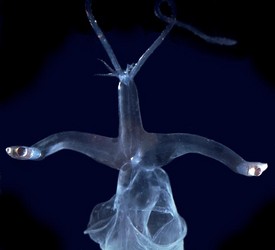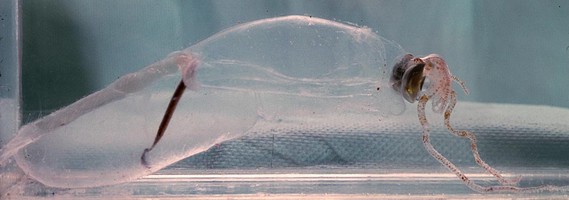Bathothauma
Bathothauma lyromma
Richard E. Young and Katharina M. Mangold (1922-2003)Bathothauma contains one recognized species. Voss, et al. (1992), however, suggest that four species may exist.
Introduction
Bathothauma lyromma is one of the more highly modified cranchiids. The paralarval stage reaches a very large size (ca. 10 cm ML) and possesses very long eye stalks and has a very long brachial pillar. Both are resorbed in the subadult. The adult reaches 20 cm ML (Nesis, 1982). This species is circumglobal in distribution from tropical to high latitudes (Voss, 1980).
Brief diagnosis:
A taoniin ...
- with widely separated paddle-shaped fins.
Characteristics
- Tentacles
- Tentacular club with suckers only.
- Tentacular stalk with two series of suckers and pads proximally, four series near club forming elongate carpal group.
- Head
- Beaks: Descriptions can be found here: Lower beak; upper beak.
- Beaks: Descriptions can be found here: Lower beak; upper beak.
- Funnel
- Funnel valve absent.
- Funnel organ with inverted V-shaped dorsal pad
- Mantle
- Tubercles absent (or virtually absent) from funnel-mantle fusion.
- Tubercles absent (or virtually absent) from funnel-mantle fusion.
- Fins
- Fins paddle-shaped, subterminal.
- Fins widely separated (insert on lateral, expanded ends of transverse extensions of posterior end of gladius).*
- Photophores
- One on each eye.**
- Arm-tip organs of adult females unknown.
*Within Cranchiidae, unique to this genus.
**Unusual feature within Cranchiidae; shared only with Helicocranchia.
Comments
Characteristics above are from Voss (1980).
Life History
The paralarva is very distinctive with extremely long eye-stalks, a long brachial pillar, widely separated fins and an unusual chromatophore pattern.



Figure. Left - Dorsal view of a large paralarva (ca. 50 mm ML) B. lyromma, Hawaiian waters. Photograph by R. Young. Right - Ventral and dorsal views of a small paralarva (ca. 5 mm ML) of B. lyromma, Hawaiian waters. The drawings emphasize the eye-rostrum by showing the eyes in different orientations: The left eye is seen in a side view and the right eye in either a ventral view (left drawing) or a dorsal view (right drawing). Drawings by R. Young. The scale bar is 1 mm.
Distribution
Vertical distribution
The vertical distribution of B. lyromma off Hawaii exhibits a clear ontogenetic descent. No adults were taken in this study but they probably occur at depths greater than 1000 m.

Figure. Vertical distribution chart of B. lyromma, Hawaiian waters. Captures were made with both open and opening/closing trawls. Bars- fishing depth-range of opening/closing trawl. Circle- Modal fishing depth for either trawl. Blue-filled circles- Night captures. Yellow-filled circles- Day capture. Chart modified from Young (1978).
Geographical distribution
The genus is found circumglobally in tropical and subtropical waters except for an apparent absence from subtropical waters of the South Atlantic. It also extends into temperate waters in the northeastern Atlantic and South Pacific (Voss, 1992).
References
Chun, C. 1910. Die Cephalopoden. Oegopsida. Wissenschaftliche Ergebnisse der Deutschen Tiefsee-Expedition, "Valdivia" 1898-1899, 18: 1-522 + Atlas.
Voss, N. A. 1980. A generic revision of the Cranchiidae (Cephalopoda; Oegopsida). Bull. Mar. Sci., 30: 365-412.
Voss N. A., S. J. Stephen and Zh. Dong 1992. Family Cranchiidae Prosch, 1849. Smithson. Contr. Zool., 513: 187-210.
Young, R. E. (1978). Vertical distribution and photosensitive vesicles of pelagic cephalopods from Hawaiian waters. Fish. Bull., 76: 583-615.
Title Illustrations

| Scientific Name | Bathothauma lyromma |
|---|---|
| Location | off Hawaii |
| Life Cycle Stage | subadult |
| View | lateral |
| Image Use |
 This media file is licensed under the Creative Commons Attribution-NonCommercial License - Version 3.0. This media file is licensed under the Creative Commons Attribution-NonCommercial License - Version 3.0.
|
| Copyright |
© 1996

|
| Scientific Name | Bathothauma lyromma |
|---|---|
| Reference | from Chun, C. 1910. Die Cephalopoden. Oegopsida. Wissenschaftliche Ergebnisse der Deutschen Tiefsee-Expedition, "Valdivia" 1898-1899, 18: 1-522 + Atlas. |
| Life Cycle Stage | paralarva |
| Size | ca. 65 mm ML |
| Type | holotype |
About This Page

University of Hawaii, Honolulu, HI, USA
Katharina M. Mangold (1922-2003)

Laboratoire Arago, Banyuls-Sur-Mer, France
Page copyright © 2019
 Page: Tree of Life
Bathothauma . Bathothauma lyromma .
Authored by
Richard E. Young and Katharina M. Mangold (1922-2003).
The TEXT of this page is licensed under the
Creative Commons Attribution-NonCommercial License - Version 3.0. Note that images and other media
featured on this page are each governed by their own license, and they may or may not be available
for reuse. Click on an image or a media link to access the media data window, which provides the
relevant licensing information. For the general terms and conditions of ToL material reuse and
redistribution, please see the Tree of Life Copyright
Policies.
Page: Tree of Life
Bathothauma . Bathothauma lyromma .
Authored by
Richard E. Young and Katharina M. Mangold (1922-2003).
The TEXT of this page is licensed under the
Creative Commons Attribution-NonCommercial License - Version 3.0. Note that images and other media
featured on this page are each governed by their own license, and they may or may not be available
for reuse. Click on an image or a media link to access the media data window, which provides the
relevant licensing information. For the general terms and conditions of ToL material reuse and
redistribution, please see the Tree of Life Copyright
Policies.
- Content changed 26 March 2019
Citing this page:
Young, Richard E. and Katharina M. Mangold (1922-2003). 2019. Bathothauma . Bathothauma lyromma . Version 26 March 2019 (under construction). http://tolweb.org/Bathothauma_lyromma/19549/2019.03.26 in The Tree of Life Web Project, http://tolweb.org/












 Go to quick links
Go to quick search
Go to navigation for this section of the ToL site
Go to detailed links for the ToL site
Go to quick links
Go to quick search
Go to navigation for this section of the ToL site
Go to detailed links for the ToL site